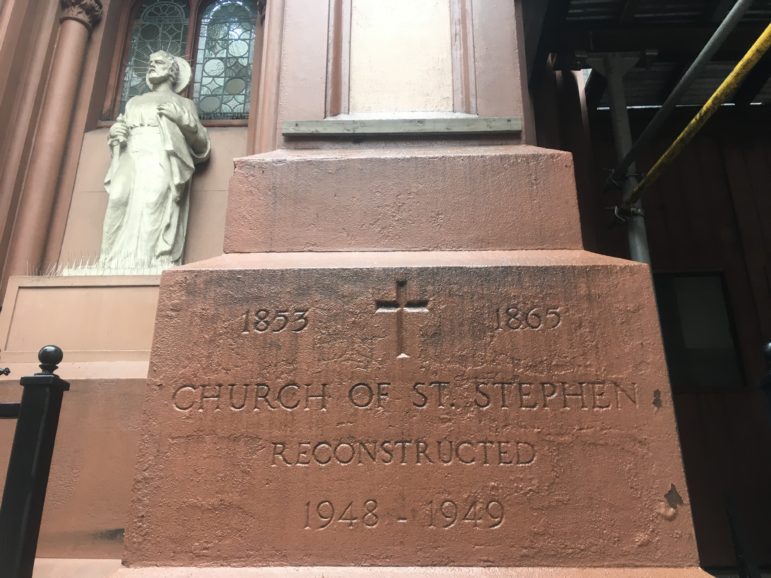
Dianna DuCroz
James Renwick, Jr., designed St. Stephen's along with St. Patrick's Cathedral and the Smithsonian Institution building in Washington, D.C.
Two white marble saints keep watch over the arched doorways at St. Stephen’s Church although no one enters or leaves through them. The 160-year-old brownstone building they guard has sat in silence over this midblock stretch of East 28th Street since the parish merged with another in 2015.
St. Stephen’s was closed by the Archdiocese of New York as part of its Making All Things New restructuring initiative. Although some closed churches have been sold and a few demolished, St. Stephen’s may have a happier ending.
“The church is beautiful,” says Mark Thompson, a longtime member of Community Board 6, “but the inside is what’s really really important.”
Designed by James Renwick, Jr., St. Stephen’s Romanesque Revival architecture is “highly unusual” for Catholic churches of its era, according to the New York City Landmarks Preservation Commission. Renwick, a major architect of the period, designed such landmarks as Manhattan’s St. Patrick’s Cathedral and the Smithsonian Institution building in Washington, D.C.
St. Stephen’s stands out, however, for another reason: its 43 colorful murals painted by Constantino Brumidi, an immigrant artist whom a 2005 U.S. Senate resolution called the “Michelangelo of the Capitol,” in honor of the elaborate frescoes he created in the U.S. Capitol.
“Aside from the nation’s Capitol, Saint Stephen’s is the only other major site of Brumidi’s work in the United States, and preserving his murals is of vital importance not only to the parishioners, but also to all lovers of art,” parishioner Eva-Marie Lassiter wrote in a 2002 article for the National Italian American Foundation.
Archdiocese officials recognize its significance as well. “It has such history,” says Angel Falcon, coordinator of special projects for numerous parishes in Manhattan. “You feel the spirit.”
“The outside doesn’t suggest the grandeur inside,” Falcon says.
The centerpiece of Brumidi’s work at St. Stephen’s is a 22- by 44-feet mural of the Crucifixion, the largest of its kind in the United States, according to Lassiter. In addition to the murals, Brumidi painted the church’s ceilings, walls, and 54 cast-iron columns.
But over the years, the ceilings and columns were painted over, and murals were damaged. A 2008 analysis estimated a $7 million cost to restore Brumidi’s murals, according to Lassiter.
Efforts by advocates to obtain National Historic Landmarks designation, an honor reserved for buildings of national significance, failed in 2005 when the archdiocese declined to support it, according to Ann Friedman, director of the Sacred Sites grants program for the New York Landmarks Conservancy.
Two years later, however, the archdiocese did not oppose city landmark status for St. Stephen and two other Renwick-designed churches, an unusual outcome Friedman attributes in part to then-Cardinal Edward Egan’s recognition of St. Stephen’s importance.
The landmark designation prevents demolition of the church and makes it eligible for grants to aid in restoration costs, Friedman says. The landmark protections do not apply, however, to the interior of the church, including the murals.
One saving grace for St. Stephen’s is the thriving Epiphany School, which shares the property, Falcon said. The archdiocese also has deconsecrated the church, Falcon says, opening it “to profane use but not sordid use,” such as occasional film shoots, to bring in extra revenue.
As for long-term plans, church officials said they are considering options for a new use and have no intention to sell the building. Falcon is optimistic that “in the next 3-5 years, everything will come together,” he said. “We have really good people working on it.”
While some former churches and synagogues have found new lives as theaters, brew pubs or shopping arcades, Falcon says the goal for St. Stephen is to keep it as a real place of worship.
“St. Stephen’s has a real future,” Falcon says. “This one, we have a real chance.”
City Limits’ reporting on the intersection of art and policy is supported by the Laurie M. Tisch Illumination Fund. City Limits is solely responsible for all content.









2 thoughts on “Artwork Could Be the Salvation for a Shuttered Church in Manhattan”
Pingback: Artwork Could Be the Salvation for a Shuttered Church in Manhattan
NYC’s Catholic population is dwindling. The NYCDOE recently purchased the lovely 7 acre St. John’s Villa Academy site on S.I. I’m disappointed that a luxury home developer didn’t snap up the property with it’s views of the Verrazzano and Lower NY Bay. SI needs the school seats but homes would have provided tax revenue for the city.
https://www.silive.com/news/2018/07/new_york_city_will_acquire_st.html